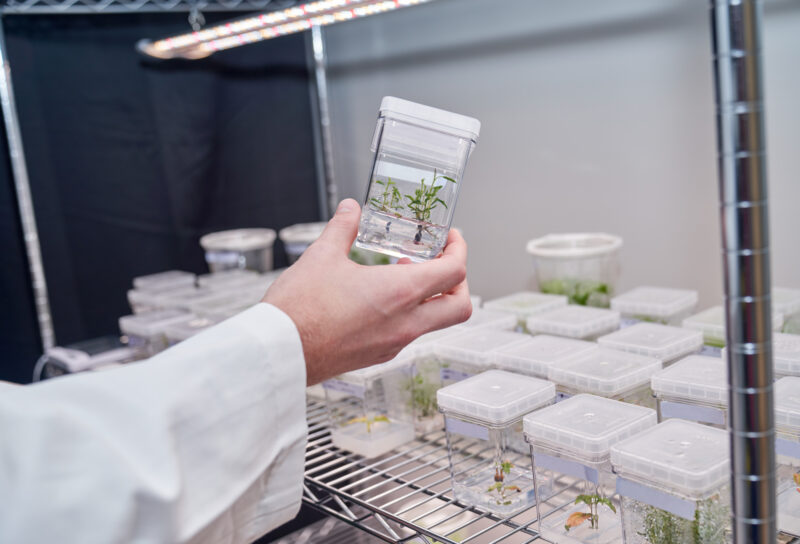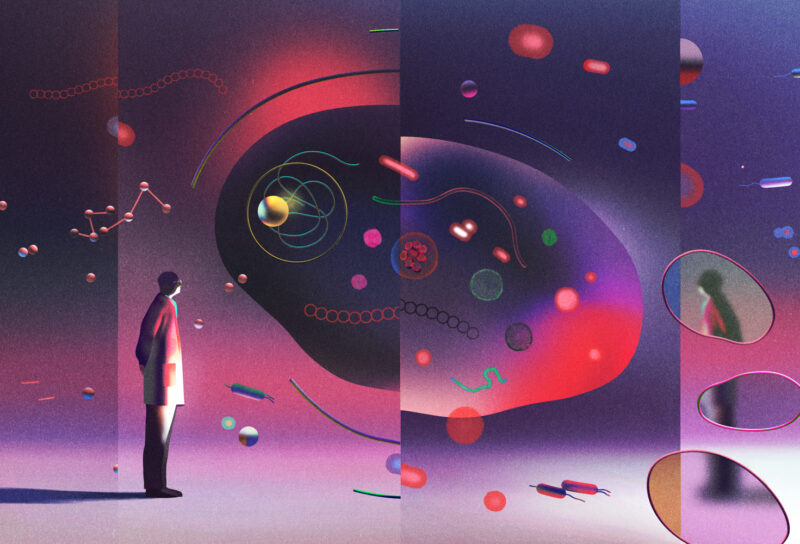Olivier Duchamp has been collecting tumors for 25 years. Bladder, colon, kidney, liver, lung, breast, skin, and prostate tumors — all excised from cancer patients. Duchamp heads the department of translational pharmacology at Oncodesign Services, a French drug discovery research firm. Oncodesign’s mission is to predict the best cancer treatments. And they do so by testing “xenografts” made from real patients’ tumors, one by one.
Every tumor is different. We may call certain cancers by the same name or classify them by the same body part, but the variable genomic instructions buried in each tumor (and patient) makes them unpredictable.
Decades of technological advances have brought down the cost of gene sequencing, so it’s becoming more feasible for doctors, researchers, and patients to know what they’re up against. That has set the stage for a tectonic shift in cancer treatment. Drug developers are veering from small molecule drugs toward “biologics.” These protein and cell-based drugs promise to supercharge cancer treatment. CAR T therapy lets scientists tailor drugs that target tumors by genetically engineering immune cells. Or, by engineering bacteria to colonize tumors they can deliver lethal payloads. Oncologists have long lists of drugs from which to choose for each patient, but then what? They can’t dose a patient with all of them. As the arsenal of cancer treatments expands, we need better ways to predict the right choice.
That’s where Duchamp’s collection comes in. Oncodesign grows human tumor cells in an animal — usually a mouse — to create an individual model of their cancer. They then use these living models to test a variety of treatment options and find the ones that work the best.
Unfortunately, these xenografts seem fundamentally unscalable. Each model is so specific, each treatment so individualized. This is where personalized medicine faces a counterintuitive challenge: how do you scale something that is inherently not meant for scale? Though time-intensive and costly in their current form, xenografts may still be the key to individualized therapies.
Grow spoke with experts to better understand whether large-scale personalized medicine is even possible. If it is, will xenografts play a role? If it isn’t, how can we imagine getting there?
Living Models
There are currently more than 200 unique tumors in Duchamp’s collection. His company develops in vivo tumor models for other companies to test their drugs. Oncodesign’s xenograft service is a “single mouse preclinical trial,” in which patient-derived tumors are introduced to small groups of one or two mice. “We can consider that one model represents one patient, and we can mimic a clinical trial in animals and test compounds to understand their mechanism of action,” Duchamp says. This service allows drug developers to understand how different tumors respond to their drug as well as how responses change when different drugs are combined.
Building on this approach, Duchamp collaborated with a team of Oncodesign researchers to develop xenograft models specifically for hepatocellular carcinoma — the most common type of liver cancer. These models have helped them understand the progression of these tumors. They also inspired new drug combinations. One such hybrid of two drugs, for example, has shown promise in reducing tumors in mice and extending their life span. Proponents of xenografts argue that by perfecting this type of approach, doctors may one day find the right treatment for individual patients in time to save their lives.
Xenografts, Duchamp concedes, are far from perfect. “The lag-times to obtain tumors and to test many compounds is not compatible with the time needed by the clinicians,” he says. Regulatory hurdles are also becoming more of a challenge: “In France, the ministry and many people are pushing to reduce the use of animals in research.”
Xenografts also face an enormous scientific challenge. Tumors are engrafted onto immunodeficient mice to prevent the mouse’s immune system from recognizing the tumor as foreign and rejecting it. In an ideal world, xenografted mice would have “humanized” immune systems , thus creating a more accurate representation of a human body’s fight against the tumor. The interaction between the tumor and the immune system plays a crucial role in cancer progression and its responsiveness to therapies. Currently, xenograft researchers can’t fully incorporate the human immune system and human tumor tissue into the mouse model. For example, cancer-associated fibroblasts are a major component of stroma, the tissue that surrounds tumors. Duchamp says that, so far, Oncodesign can humanize the immune system, liver and the skin, but not the fibroblast component of tumors.
Since researchers can’t recreate the immune system using a single model, Duchamp believes that scaling the approach will require combining models. They have started developing in vitro human tumor organoids, three-dimensional “mini organs” made of cultured cells. These consist of tumor cells and mimic the structure and growth of the real thing.
They’re even finding better results by looking beyond the mouse: “For prostate cancer, less than 1% of the tumors are able to grow in mice, but when you take a prostate tumor coming from patients and engraft the tumor in a chicken embryo, we obtain 100%.”
Thinking Smaller
Meenhard Herlyn has pioneered the use of three-dimensional “artificial skin” cultures to study the interactions between tumor and normal cells that contribute to tumor growth. He has also transformed the scientific view on stem cells and how they relate to cancer. “We want to engineer a tumor that is very similar to what we see in patients, and I think over time this is possible,” says Herlyn, who directs the Wistar Institute Melanoma Research Center.
Herlyn’s work offers a compelling glimpse into how doctors might adopt personalized medicine, without relying on mice. Overall, the organoid model system has provided faster and more robust outcomes. They also require much less time and money than mouse models. His lab has started to construct patient-derived tumor organoids organized with immune systems that even include an artificial thymus. “We can grow T cells, B cells, and monocytes,” Herlyn says. Previously, researchers used thymuses from human embryos, but it’s now becoming possible to grow them from blood cells that have been reprogrammed into stem cells.
“The big advantage of the [stem cells] system is that we have the tumor and the immune system from the same patient,” he says.
But the challenge will be how to handle and make sense of the large and complicated datasets that will be generated from these organoids. “To bring together the different cell types that are in a human tumor into a scalable system we still need good bioreactors, we need really good coordination,” Herlyn says. “All of that is challenging but not impossible.”
A necessary step: developing more computational tools to extract meaningful messages from the data. “The challenge,” Herlyn concludes, “is combining the wet lab with the computational lab.” If they meet this challenge, scientists could radically change how we think of personalized medicine.
Another Way
“We all have to keep in mind that there is never going to be a single model,” says Carol Bult. In 2012, Bult was appointed to be the Deputy Director of the PDX and Cancer Avatar Program at The Jackson Laboratory. “One of the things I was most excited about for the PDX program,” she says, “was not the individual models, but the fact that you could take the same tumor and subject it to many different perturbations, look at the results, and then go back and test the same tumor again.”
However, like Duchamp, Bult emphasizes that xenografts are still held back by too many hurdles. “It does not scale well because it takes a long time to humanize.”
Bult believes efforts to collect xenograft data are key to creating predictive computational models in the future. “We are now working with a lot of different groups across the world that use PDXs and figuring out how to standardize the data and make it available in a form that would allow more robust machine learning,” she explains. Researchers need to work together to define standards for how to describe xenograft models and drug responses and how those can be structured into shareable datasets.
Bult has another idea for how to reach a future of personalized medicine — one that reimagines the role of xenografts and organoids.
Suppose that researchers load a database with the genomic data of patients’ cancers used in xenografts, along with which treatments worked on which xenografts, and which didn’t. Once that database grows large enough, researches could have enough information to reverse engineer the rules of cancer biology at play. A machine learning algorithm can tease out the pattern between genome and treatment success. Then, doctors can apply that algorithm to help predict which treatment would best treat their patient. The continuously growing banks of xenograft data will fuel machine learning algorithms, enabling them to feed on millions of unique cancer case studies to predict effective treatment for future patients.
“I feel very strongly that if we collect the data in a systematic and standardized way, we’ll be able to develop very powerful predictive computational models,” she says. Bult’s team currently works with groups around the world to figure out how to standardize xenograft data to create large databases of cancer information. And Bult envisions taking this one step further: “What if we could identify individuals who are most likely to develop cancers and change their medical care so that they get screening earlier—before we have patients?”
This position flips the idea of xenografts inside out. It would transform how we study cancer data.
Rather than focusing on treating cancer, what if we work to figure out how to fully prevent it? “What excites me is leveraging the model system to understand what the predisposing factors are to cancer development,” she says. “It may not necessarily fit the model being scalable, but I think it’s the model being transformational.”
Xenografts’ poor scalability may not be a dealbreaker, after all. An AI-centric vision repurposes them as a stepping stone towards a larger-scale solution. The idea of scaling personalized medicine turns into a data problem. Treating more people faster may be less about producing more xenografts faster, and more about siphoning as much knowledge as possible from each one. If that happens, our most elusive and dynamic ailment would become evermore predictable.


